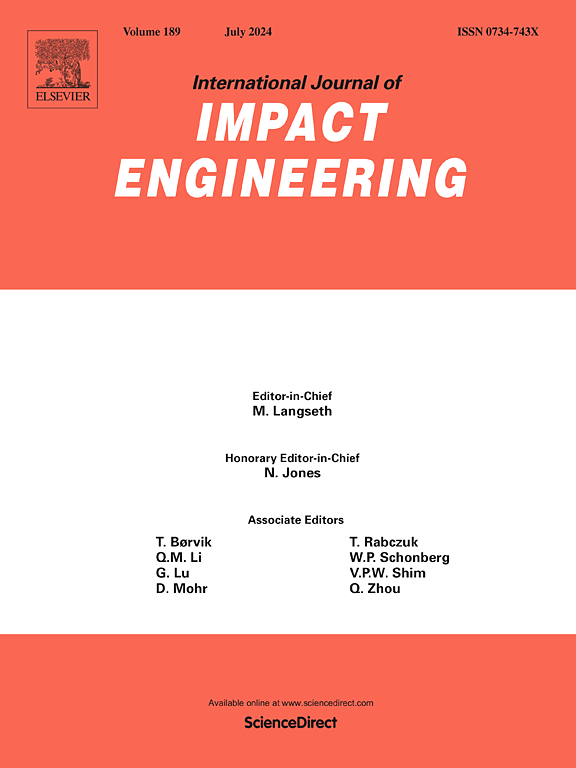Dynamic failure analysis of lithium-ion battery under high-velocity impact using the FE-SPH based simulation
IF 5.1
2区 工程技术
Q1 ENGINEERING, MECHANICAL
International Journal of Impact Engineering
Pub Date : 2025-03-22
DOI:10.1016/j.ijimpeng.2025.105319
引用次数: 0
Abstract
Lithium-ion batteries are inevitably subjected to mechanical abuses of high-velocity impact on the battlefield, challenging the safety of electrified military equipment. It is vital to understand the failure mechanisms of batteries under high-velocity impacts, nevertheless limited by the lack of effective numerical and experimental methods. For this purpose, a FE-SPH based numerical model considering equivalent homogeneous electrodes is established to investigate the dynamic failure behaviors of LIBs under high-velocity impact. Compared to FEM method using element deletion, the FE-SPH method addresses the problem of numerical sudden drop in resistance force during dynamic indentations. We precisely simulate damage morphologies of impacted batteries compared to previous ballistic tests, and the debris cloud of crushed battery components is well reproduced. The effect of stress wave in the dynamic failure of electrodes and separators in LIBs is revealed during the penetration stage, which affects the fragment distribution in the structural response stage of impacted batteries. Furthermore, we systematically investigate the effects of battery thickness, impact velocity and penetrator shape on the damaged morphologies and structural debris cloud of impacted LIBs. The mechanical failure sequence of battery components is then compared between the low-velocity and high-velocity impact. It's deduced that cathode and anode layers fail before the rupture of separators in LIBs under the high-velocity impact, underlying that the heat generation is not mainly attributed to instantaneous electrochemical short circuits caused by the rupture of the separator. This study provides new insights for understanding the failure mechanism and protection design for batteries.
基于FE-SPH仿真的锂离子电池高速碰撞动态失效分析
锂离子电池在战场上不可避免地受到高速冲击的机械滥用,对电气化军事装备的安全性提出了挑战。了解电池在高速撞击下的失效机制是至关重要的,但由于缺乏有效的数值和实验方法而受到限制。为此,建立了考虑等效均匀电极的FE-SPH数值模型,研究了lib在高速冲击下的动态破坏行为。与采用单元删除法的有限元方法相比,FE-SPH方法解决了动态压痕过程中阻力数值骤降的问题。与以往的弹道试验相比,我们精确地模拟了撞击电池的损伤形态,并很好地再现了破碎电池部件的碎片云。应力波对锂离子电池电极和隔板在侵彻阶段动态失效的影响,影响了冲击电池结构响应阶段的碎片分布。此外,我们系统地研究了电池厚度、撞击速度和穿透体形状对撞击lib损伤形态和结构碎片云的影响。然后比较了低速和高速撞击下电池部件的机械失效顺序。可以推断,在高速撞击下,LIBs中阴极层和阳极层在隔板破裂之前就失效了,这说明热的产生并不主要是由于隔板破裂引起的瞬时电化学短路。该研究为理解电池失效机理和保护设计提供了新的思路。
本文章由计算机程序翻译,如有差异,请以英文原文为准。
求助全文
约1分钟内获得全文
求助全文
来源期刊

International Journal of Impact Engineering
工程技术-工程:机械
CiteScore
8.70
自引率
13.70%
发文量
241
审稿时长
52 days
期刊介绍:
The International Journal of Impact Engineering, established in 1983 publishes original research findings related to the response of structures, components and materials subjected to impact, blast and high-rate loading. Areas relevant to the journal encompass the following general topics and those associated with them:
-Behaviour and failure of structures and materials under impact and blast loading
-Systems for protection and absorption of impact and blast loading
-Terminal ballistics
-Dynamic behaviour and failure of materials including plasticity and fracture
-Stress waves
-Structural crashworthiness
-High-rate mechanical and forming processes
-Impact, blast and high-rate loading/measurement techniques and their applications
 求助内容:
求助内容: 应助结果提醒方式:
应助结果提醒方式:


